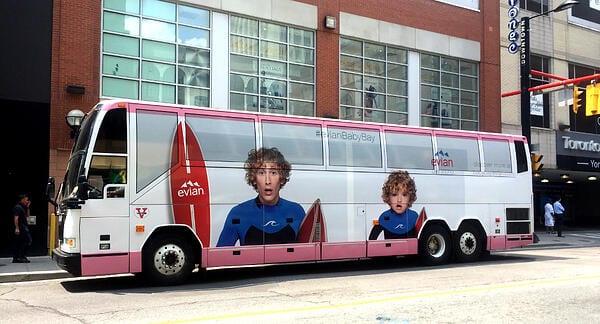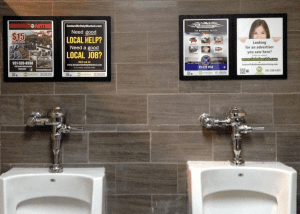In the competitive race for consumer attention, every second matters. As marketing professionals, we chase visibility, dwell time, and engagement — all while trying to land in front of the right people, at the right moment, in the right mindset. But as TV ad bus formats become increasingly common across transit systems, an uncomfortable question arises:
Are commuters really paying attention?
Let’s take a closer look at how tv ads bus strategies stack up against a powerful and often-overlooked format: in-hand advertising — like branded coffee sleeves, pharmacy bags, pizza boxes, and bar coasters. The evidence suggests that while tv advertising bus placements seem innovative, they often fail to deliver meaningful engagement compared to ads consumers physically interact with.
The Rise of TV Ad Bus Formats — and Their Hidden Weaknesses
At first glance, TV advertisement bus solutions seem promising. Screens installed inside public buses display rotating videos from local and national advertisers. These formats are sold as dynamic, location-aware, and capable of running targeted content based on the time of day or route.
But real-world performance tells a different story.
The Commuter Reality: Noise, Motion, Distraction
Commuters on buses are bombarded with auditory announcements, street noise, and visual clutter.
Riders are usually looking at their phones, talking, or zoning out — not watching screens silently playing in the background.
Most tv ads bus formats run without sound, relying on visuals alone — further reducing impact.
Result? Attention is split. Engagement is minimal. Brand messages get lost in the chaos.
Why In-Hand Media Wins Where TV Ads Bus Campaigns Fail
Now compare that environment to the calm moment of sipping coffee, eating takeout at home, or flipping through a coupon while waiting at the pharmacy.
In-hand media — like branded pizza boxes or coasters — enters the consumer’s space when they are focused, relaxed, and physically interacting with the ad.
Let’s break down the critical advantages.
Dwell Time vs. Drive-By Viewing: The Core Flaw of TV Advertisement Bus Formats
The average tv ad bus screen cycles through multiple ads in 15- to 30-second rotations. But studies show that the average rider may only glance at the screen — if at all. Most commuters spend that time on their phones or looking outside.
In contrast:
A pizza box remains in a home for over 30 minutes
A pharmacy bag might stay on a kitchen counter for hours
A coffee sleeve is held and touched for the entire drink duration
This physical interaction leads to higher brand recall, message retention, and intent to act.
Sensory Engagement: Why Touch Beats Transit Screens
The tv advertising bus format is 100% visual. In a noisy, shaking vehicle, even those visuals lose clarity.
In-hand advertising, however, taps into multi-sensory engagement:
Touch: The consumer is holding the ad (coaster, sleeve, box)
Context: The experience is tied to routine behaviors (eating, relaxing, waiting)
Relevance: Ads are often hyperlocal, related to their immediate surroundings
Psychologically, touch creates memory. Consumers are more likely to recall brands they physically engage with — making in-hand formats far superior to tv ads bus impressions.
Message Retention: Simplicity Wins in Calm Spaces
Marketing thrives on clarity. But TV ad bus screens are small, often unreadable from a distance, and loop multiple messages in sequence. That means:
Competing messages overlap
Viewers only get a fraction of your message
There’s no direct CTA or easy way to act
In-hand formats simplify the funnel. A pizza box with a bold QR code. A pharmacy bag with a discount. A coffee sleeve with a CTA to scan and win.
There’s no guessing, no distraction — just direct action.
Case Study Comparison: TV Ads Bus vs. In-Hand QR Activation
Let’s look at a sample scenario:
Format |
Campaign |
Dwell Time |
Engagement Rate |
QR Scan Rate |
Brand Recall |
TV Ad Bus |
15-sec video loop for a local meal delivery app |
<10 sec (glance) |
Low |
<0.5% |
Very low |
In-Hand Media |
QR-linked promo on pizza boxes for same app |
30+ min |
High |
3–7% |
High |
Conclusion: In the same market, with the same message, the in-hand format outperformed the transit screen on every key metric.
Distribution: TV Advertisement Bus Sounds Local, But Is It?
A major selling point of tv ads bus is geographic coverage — your ad circulates the city. But coverage doesn’t equal precision.
Buses move constantly. Your hyperlocal bakery ad might be showing in neighborhoods where you don’t deliver. Worse, commuters on buses may not be your target demographic.
In-hand ads, meanwhile, are strategically placed:
Coffee sleeves in downtown cafes
Coasters in college bars
Pizza boxes in residential areas
Pharmacy bags in high-footfall medical locations
It’s laser-targeted, not scattershot.
Cost Efficiency: You’re Paying for Movement, Not Engagement
TV advertising bus packages aren’t cheap. You pay for impressions based on screen time, not attention. And you often compete with 5+ other ads in the rotation.
In-hand media:
Has lower CPMs (as low as $1–$2)
Is exclusive — only your brand on that box or sleeve
Offers measurable QR-driven results






